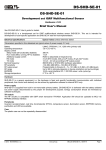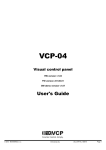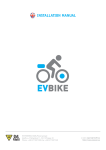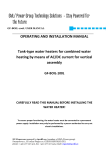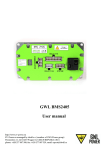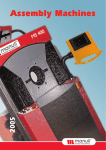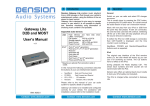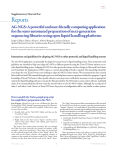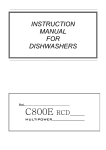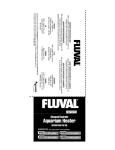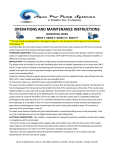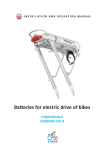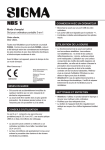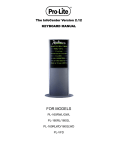Download GWL/ Power Group Technology Solutions – Stay Powered for the
Transcript
GWL/ Power Group Technology Solutions – Stay Powered for the Future GWL/Power Specification Document Flexible solar panels User Manual October 2013 Warnings and electrical hazards All instructions should be read carefully and understood before proceeding with the installation, connection, use and maintenance of the photovoltaic module. In the event that more panels are connected in series, ensure that the voltage is less than 70 volts; otherwise, the contact with the connectors could produce harmful electric shock and / or death. Before installing the module check the need for any permits and / or concessions required by current legislation. Unless otherwise specified, it is recommended to comply with the most recent national l or international laws. The panel must remain in its packaging until installation to avoid risks of damage. Incorrect installation can compromise the entire system. Additional equipment may be required such as grounding, fuses, lightning arresters, disconnectors, etc. Do not use different types of modules in the same system connected in series. Do not stress out the form with mechanical stress, do not drop or throw objects out the form, do not walk on it with sharp high heel shoes. Do not apply paint or adhesive on the form. Do not concentrate sunlight or other sources of artificial light on the forms. Always work on the modules in dry conditions, even for tools. Use tools properly covered with insulating material during the electrical connection of the modules. Fully cover the surface of the module with blackout material during installation, removal or maintenance, one PV module generates electricity when exposed to light. Avoid electrical shock during installation, wiring, and maintenance of the form. Do not touch the terminals when the module is exposed to light, provide for the installation with appropriate means of protection to prevent electric shock. Do not install the module where flammable gases or vapors are present, or when dangerous sparks may occur. Do not allow children to approach to the module when it has to be installed. A module that is damaged in some way must never be installed and used. Use the panel only for the purpose for which it was designed. Follow all manufacturer’s instructions. Do not dismantle or remove any part or label affixed by the manufacturer. Recommendations The modules have to be glued to the fix structure, strictly following these instructions. BE VERY CAREFUL NOT TO EVER BEND OVER THE PV MODULE: CURVES THAN 10% CAN DAMAGE THE CELLS OR THE FORM! The structure on which is pasted the module must be able to withstand, without deformation, weathering even violent, such as snow and wind and, in the case of marine applications, salt and storm surges. The support, on which the module is secured, in any case, should not be subject to any kind of twist. Flexing or bending of the support repeated over time, can cause irreparable tears of the components of the module, reducing the yield or even making it completely inactive. The module must be installed so that air can circulate freely at least on the side facing the sun. This reduces the operating temperature and increases performance. The sections of electrical wires for the connections must be sufficient to ensure that the voltage drop does not exceed 1% of the rated voltage. We recommend the use of fire-resistant cable suitable for outdoor applications. Bonding Modules (optional method) The bonding of the modules should be performed with the utmost care and precision. The doublesided structural adhesive allows you to remove the panel without complications within 8 hours after application. Then proceed as follows: 1. Clean the surface with a degreasing agent. 2. Mark the point of installation, defining the area or marking a scratch mark on the corners. 3. Lift the module and remove the protective film, discovering and exposing a sticky surface. It is recommended not to touch the exposed with hands. 4. Paste the panel on the surface. For this reason it is recommended to perform the bonding, two people: one who holds slightly raised and live out the form by holding the opposite long sides, and one that manages the installation and paste by pressing the “discovery” of the module on the support disk. IN THIS WILL BE VERY CAREFUL NOT TO NEVER BEND OVER THE PV MODULE: CURVE, EVEN IN RESTRICTED ZONE MODULE CAN CAUSE IRREVERSIBLE DAMAGE TO PHOTOVOLTAIC CELLS. ALSO MAKE SURE THE INITIAL PHASE OF THE FORM OF BONDING. 5. Now, install starting on the one hand by joining form in a progressive manner to prevent the formation of air bubbles. 6. After pasting, it is very important to apply pressure on the whole bonded surface. For this purpose it may be sufficient treading repeatedly the module itself, so as not to leave parts not subject to foot traffic, of course, taking care not to use too rigid and angular footwear. Electrical connections of the panel Connection system has already been applied on the panel. Connection – a junction box with MC4 connectors. MAINTENANCE The PV modules require very little maintenance, thanks to the absence of moving mechanical parts. The maintenance is reduced to the following procedures: Clean the module when it is dirty. In the case of use in a marine environment often wash with fresh water in order to avoid salt encrustation and to limit damage from salt in general; Check the condition of the electrical connections and wiring; Check the electrical performance of the system. Possible faults Due to the stringent quality controls to which PV modules are subject, cases of faults and / or defects are infrequent. Among the reasons unrelated to the manufacturing process, we can identify the following cases: water infiltration between the module and a rigid support where it is pasted caused by improper bonding. Verify the integrity of connectors and cabling. Check the wiring with the regulator and the integrity of the battery, check the fuse of the controller (if applicable). http://www.ev-power.eu EV-Power.eu managed by i4wifi a.s. (member of GWL/Power group) Prumyslova 11, CZ-10219 Prague 10, CZECH REPUBLIC (EU) phone: +420 277 007 500, fax: +420 277 007 529, email: [email protected]





